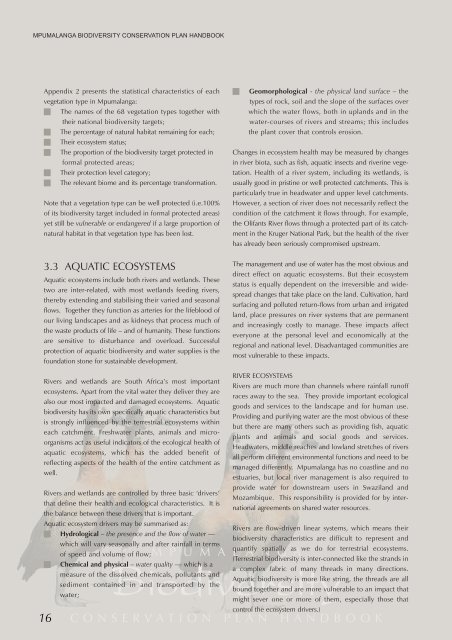Mpumalanga Biodiversity Conservation Plan Handbook - bgis-sanbi
Mpumalanga Biodiversity Conservation Plan Handbook - bgis-sanbi
Mpumalanga Biodiversity Conservation Plan Handbook - bgis-sanbi
You also want an ePaper? Increase the reach of your titles
YUMPU automatically turns print PDFs into web optimized ePapers that Google loves.
MPUMALANGA BIODIVERSITY CONSERVATION PLAN HANDBOOK<br />
Appendix 2 presents the statistical characteristics of each<br />
vegetation type in <strong>Mpumalanga</strong>:<br />
The names of the 68 vegetation types together with<br />
16<br />
their national biodiversity targets;<br />
The percentage of natural habitat remaining for each;<br />
Their ecosystem status;<br />
The proportion of the biodiversity target protected in<br />
formal protected areas;<br />
Their protection level category;<br />
The relevant biome and its percentage transformation.<br />
Note that a vegetation type can be well protected (i.e.100%<br />
of its biodiversity target included in formal protected areas)<br />
yet still be vulnerable or endangered if a large proportion of<br />
natural habitat in that vegetation type has been lost.<br />
3.3 AQUATIC ECOSYSTEMS<br />
Aquatic ecosystems include both rivers and wetlands. These<br />
two are inter-related, with most wetlands feeding rivers,<br />
thereby extending and stabilising their varied and seasonal<br />
flows. Together they function as arteries for the lifeblood of<br />
our living landscapes and as kidneys that process much of<br />
the waste products of life – and of humanity. These functions<br />
are sensitive to disturbance and overload. Successful<br />
protection of aquatic biodiversity and water supplies is the<br />
foundation stone for sustainable development.<br />
Rivers and wetlands are South Africa’s most important<br />
ecosystems. Apart from the vital water they deliver they are<br />
also our most impacted and damaged ecosystems. Aquatic<br />
biodiversity has its own specifically aquatic characteristics but<br />
is strongly influenced by the terrestrial ecosystems within<br />
each catchment. Freshwater plants, animals and microorganisms<br />
act as useful indicators of the ecological health of<br />
aquatic ecosystems, which has the added benefit of<br />
reflecting aspects of the health of the entire catchment as<br />
well.<br />
Rivers and wetlands are controlled by three basic ‘drivers’<br />
that define their health and ecological characteristics. It is<br />
the balance between these drivers that is important.<br />
Aquatic ecosystem drivers may be summarised as:<br />
Hydrological – the presence and the flow of water ––<br />
which will vary seasonally and after rainfall in terms<br />
M P U M A L A N G A<br />
of speed and volume of flow;<br />
<strong>Biodiversity</strong><br />
Chemical and physical – water quality –– which is a<br />
measure of the dissolved chemicals, pollutants and<br />
sediment contained in and transported by the<br />
water;<br />
Geomorphological - the physical land surface – the<br />
types of rock, soil and the slope of the surfaces over<br />
which the water flows, both in uplands and in the<br />
water-courses of rivers and streams; this includes<br />
the plant cover that controls erosion.<br />
Changes in ecosystem health may be measured by changes<br />
in river biota, such as fish, aquatic insects and riverine vegetation.<br />
Health of a river system, including its wetlands, is<br />
usually good in pristine or well protected catchments. This is<br />
particularly true in headwater and upper level catchments.<br />
However, a section of river does not necessarily reflect the<br />
condition of the catchment it flows through. For example,<br />
the Olifants River flows through a protected part of its catchment<br />
in the Kruger National Park, but the health of the river<br />
has already been seriously compromised upstream.<br />
The management and use of water has the most obvious and<br />
direct effect on aquatic ecosystems. But their ecosystem<br />
status is equally dependent on the irreversible and widespread<br />
changes that take place on the land. Cultivation, hard<br />
surfacing and polluted return-flows from urban and irrigated<br />
land, place pressures on river systems that are permanent<br />
and increasingly costly to manage. These impacts affect<br />
everyone at the personal level and economically at the<br />
regional and national level. Disadvantaged communities are<br />
most vulnerable to these impacts.<br />
RIVER ECOSYSTEMS<br />
Rivers are much more than channels where rainfall runoff<br />
races away to the sea. They provide important ecological<br />
goods and services to the landscape and for human use.<br />
Providing and purifying water are the most obvious of these<br />
but there are many others such as providing fish, aquatic<br />
plants and animals and social goods and services.<br />
Headwaters, middle reaches and lowland stretches of rivers<br />
all perform different environmental functions and need to be<br />
managed differently. <strong>Mpumalanga</strong> has no coastline and no<br />
estuaries, but local river management is also required to<br />
provide water for downstream users in Swaziland and<br />
Mozambique. This responsibility is provided for by international<br />
agreements on shared water resources.<br />
Rivers are flow-driven linear systems, which means their<br />
biodiversity characteristics are difficult to represent and<br />
quantify spatially as we do for terrestrial ecosystems.<br />
(Terrestrial biodiversity is inter-connected like the strands in<br />
a complex fabric of many threads in many directions.<br />
Aquatic biodiversity is more like string, the threads are all<br />
bound together and are more vulnerable to an impact that<br />
might sever one or more of them, especially those that<br />
control the ecosystem drivers.)<br />
CONSERVATION PLAN HANDBOOK

















